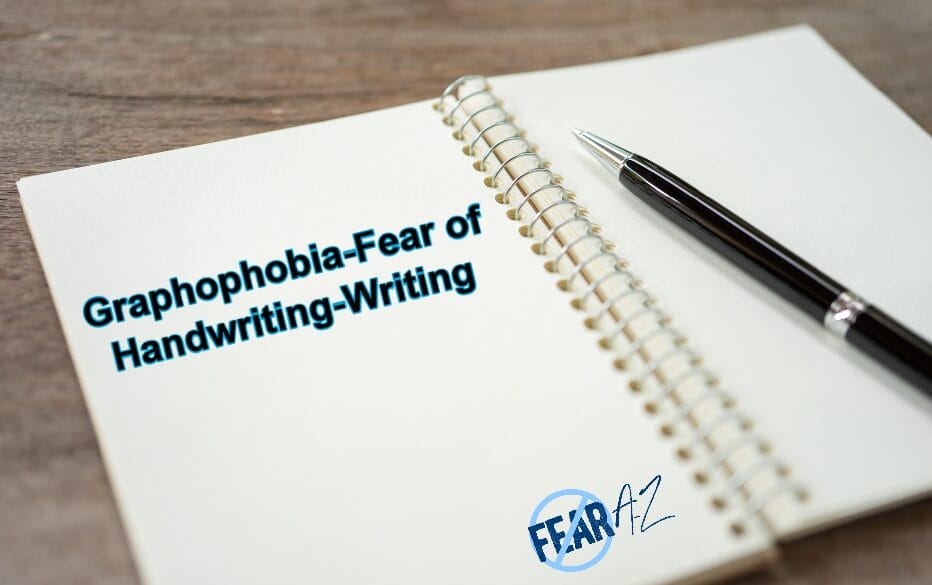Share This Article
Examining Graphophobia: The Fear of Handwriting or Writing
Do you ever feel afraid to write with a pen? When you think about needing to write something down, do you start to perspire or shake? Were you so nervous about writing essays for school that you avoided the topic altogether? Can you only communicate on paper with a printer or old-fashioned typewriter?
If you’re nodding in agreement when asked these questions, you may be experiencing graphophobia.
Does this mean you’ll never be able to communicate effectively because you’re afraid of writing? Not at all. Self-help techniques and additional forms of treatment can help you control and lessen the symptoms of this phobia.
The first step in overcoming your fear of writing is to try to trace where this fear started and what might have caused it. From there, you can concentrate on graphophobia symptoms and remedies.

Why Do People Fear Writing?
Like any other phobia, writing anxiety is quite similar. It frequently has to do with the anxiety of others judging or criticizing our writing. It’s possible, though, that you’ve never received unfavorable comments. In this case, the dread is the result of the imagination or a few isolated past experiences.
This anxiety may cause you to shy away from writing in social circumstances, hesitate to write short messages or emails, or even feel anxious when filling out forms.
If you stuggle with an overwhelming phobia of writing or handwriting, you may experience anxiety if you sleep next to a journal or other writing supplies. You might consistently shy away from writing-intensive assignments or correspondence. Even if this fear isn’t talked about as much as others, it’s important to know that if you experience it—you’re not alone.
Potential Causes of Graphophobia
There isn’t just one explanation for graphophobia, the dread of writing or handwriting. A number of things might lead to its emergence.
This dread may have originated from unfavorable past school experiences, including severe criticism from a teacher. One awkward writing experience may have made a lasting impression.
There could also be environmental influences or learned reactions from family members or friends who showed a dislike for writing. Additionally, graphophobia may be the result of a hereditary susceptibility to anxiety.
Often, a phobia develops as a result of a mix of environmental factors and past experiences.
Graphophobia Symptoms
Early diagnosis can help with management, but since phobias can interfere with everyday tasks, take them seriously.
Physical Symptoms
- Nausea
- Difficulty breathing
- Choking sensation
- Tightness in the chest
- Trembling or shaking
- Hyperventilating
- Dizziness or lightheadedness
- Sweating
- Chills
- Stomach pain
- A rise in blood pressure
Mental/Emotional Symptoms
- Fear of being judged or ridiculed
- Feeling sad and hopeless
- Fear of writing, especially in public
- Feeling like losing control
- Anger and irritability
- Fear of making mistakes
- Feeling powerless
- Panic attacks
- Anxiety
Some Strategies for Handling Graphophobia
You can start treatment as soon as you recognize that you have this phobia of writing. Try tried-and-true self-help methods that have been shown to work for many phobias before getting professional assistance.
Self-Help Methods to Manage Graphophobia
Since you are the one most aware of your emotional responses, it’s important that you understand your own feelings and behaviors. For many, self-help methods for overcoming phobias have proven to be effective.
You can begin by making small changes in your lifestyle to take your mind off of your fear. You can keep your mind active and divert from writing thoughts by exercising frequently, eating well, spending more time with friends and family, and keeping yourself busy with job or hobbies.
Techniques for Mindfulness
A kind of meditation called mindfulness involves focusing on your present emotions without passing judgment. This practice incorporates stress-relieving and relaxation-enhancing methods such as guided visualization, controlled breathing, and other tactics. Studies have demonstrated the efficacy of mindfulness in the treatment of ailments including stress, pain, anxiety, and insomnia, which can all be made worse by phobias like graphophobia, the fear of writing or handwriting.
Take Part In a Support Group
Feelings are powerful tools for relieving emotional strain. Joining a support group for others who share your anxieties might be helpful, even though talking about your phobia with friends and family may be difficult. These kinds of organizations allow you to express thoughts, feelings, and tactics without worrying about criticism, which can be relieving and provide useful coping techniques.
The Advantages of Yoga
Many people discover that yoga and meditation are surprisingly beneficial, particularly when they’re stressed. These techniques support deep breathing and focus, which can help eliminate unpleasant feelings and progressively lessen writing-related anxiety.
When to Get Expert Assistance
Living with a phobia can be especially difficult when it interferes with daily responsibilities, like writing, which is necessary for the majority of tasks related to school and work. It’s important to seek professional help if your ability to function in your everyday life is affected by graphophobia, or the dread of writing or handwriting.
If any of the following apply to you, speak with a healthcare professional:
- You get panic attacks frequently
- You find it difficult or impossible to complete assignments that require writing; or
- Your dread of writing has continued for longer than six months.
Professional Help: When Self-Help is Not Enough
With the right tools, treatment can help you better understand and control your emotions, which will enable you to think more clearly and speak to others fearlessly. Therapy can help you recover control over your emotions and behaviors by providing a secure, judgment-free environment in which to talk about your anxieties.
Cognitive Behavioral Therapy (CBT)
This type of therapy assists patients in recognizing and altering harmful thought patterns that have an adverse effect on their feelings and actions. Counseling for unreasonable worries related to writing can help lower anxiety and avoidance habits.
Hypnotherapy
When used in conjunction with other treatments, hypnosis induces a relaxed condition in which you are more receptive to recommendations. This can lessen your nervousness and let you see writing differently.
Exposure Therapy
This technique helps you become less sensitive over time and lowers anxiety by exposing you gradually to the act of writing in a controlled setting.
Combining Different Therapies
A combination of therapies is frequently the most effective approach, as no single treatment will completely eradicate a phobia. This could involve self-help techniques as well as hypnosis, CBT, psychotherapy, and practical exercises.
Let’s Conclude
While conquering the fear of writing or handwriting, or graphophobia, can seem overwhelming, it’s completely doable with the correct guidance and assistance. The first step in overcoming your fear is to acknowledge it. With the right care and encouragement from friends, family, and professionals, you may overcome your fear of writing and seize opportunities without feeling nervous.



